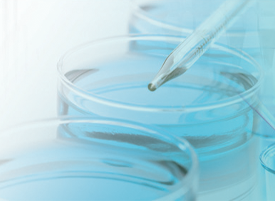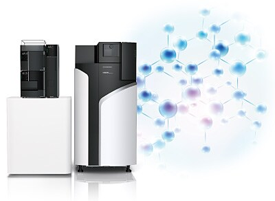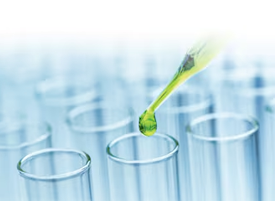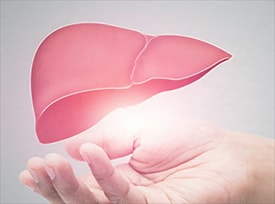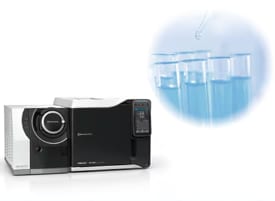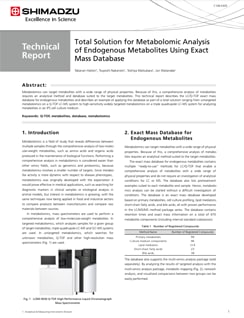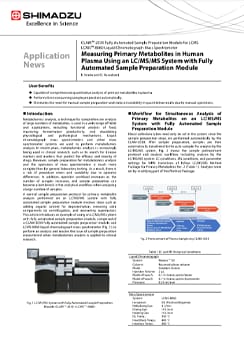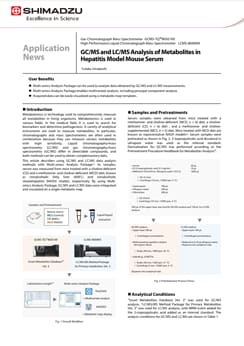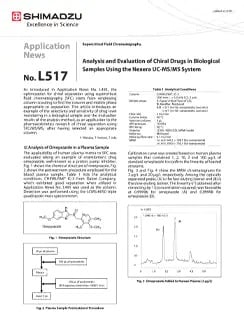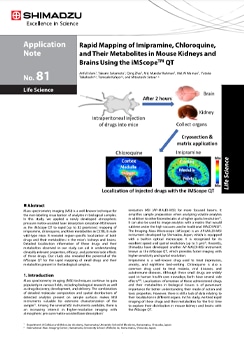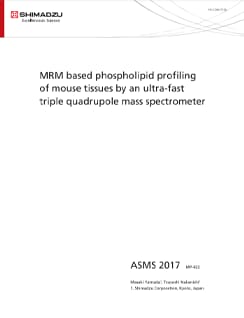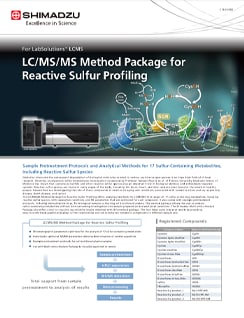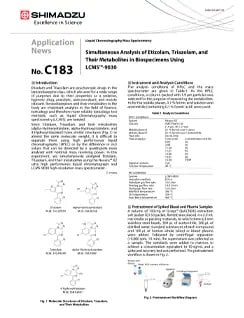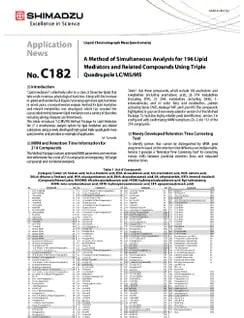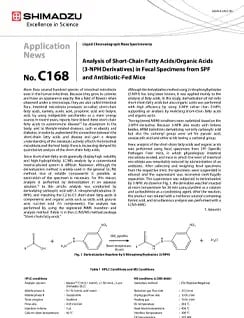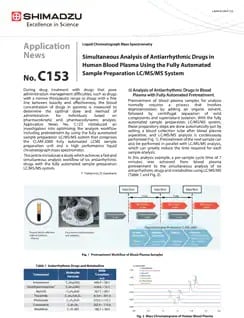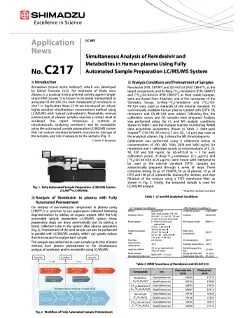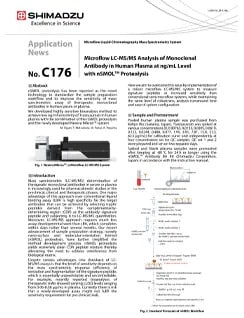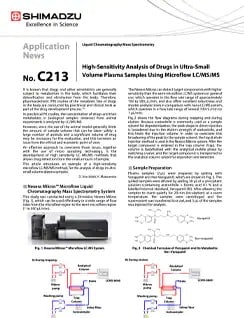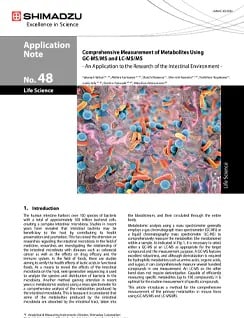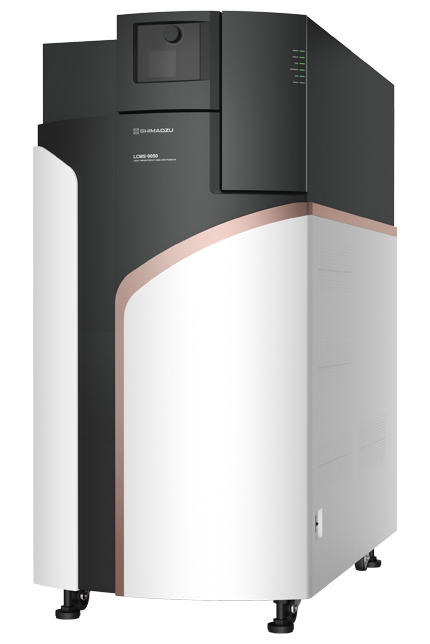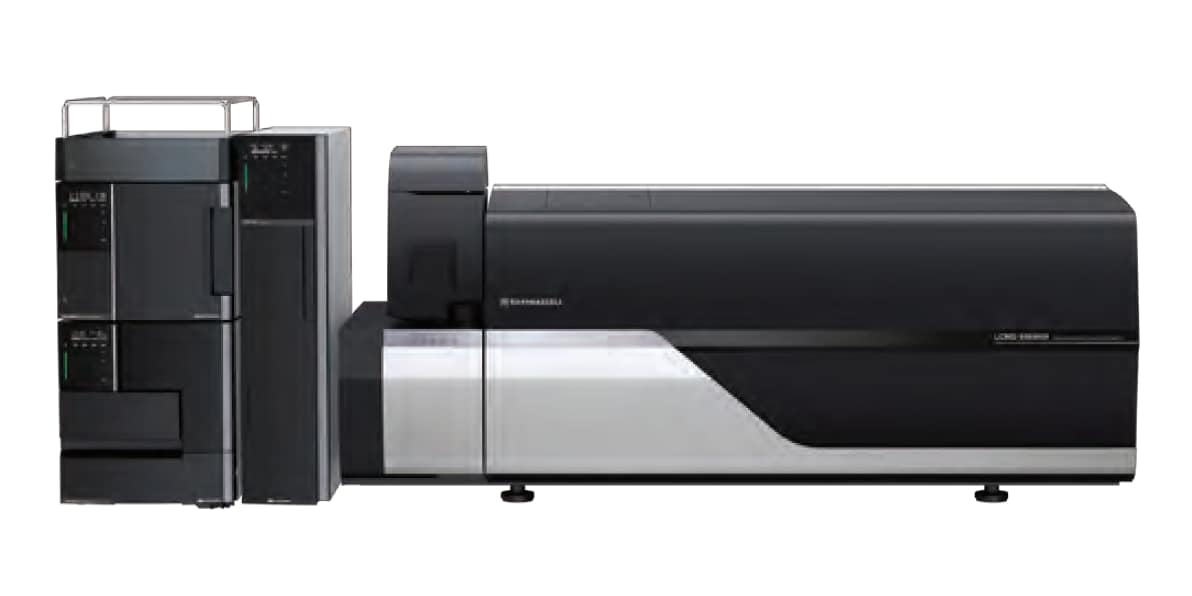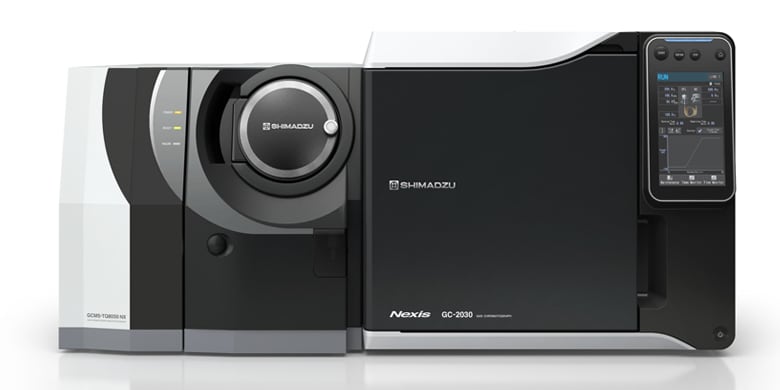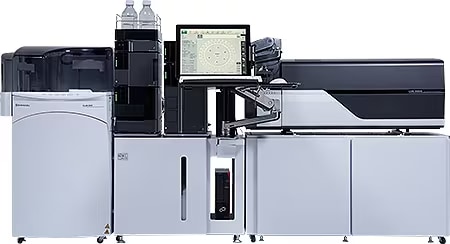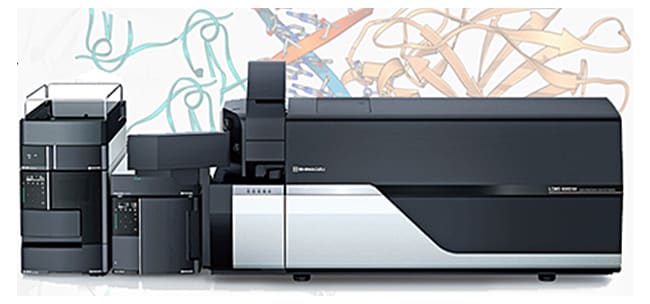Request More Information
ADME / DMPK
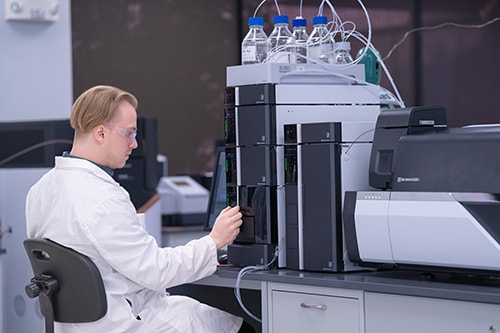
Understanding the bioactivity of new drug candidates is of vital importance in development of safe and effective therapeutic compounds. Identifying and characterizing metabolites is key in avoiding toxicity and creating awareness of potential side effects. Within drug development, there is an ever-increasing demand to provide quantitative information related to all identifiable metabolites, highlighting the need for tools such as scalable high-throughput UHPLC, high-resolution QTOF mass spectrometry and high-sensitivity TQ mass spectrometry. For volatile metabolites, powerful GC-MS/MS solutions give additional insight beyond liquid chromatography methods.
Accurate, reproducible results from your ADME/DMPK laboratory can expose biotransformation mechanisms that guide the selection and refinement of candidates. The need to obtain this information from larger sample sets, often in a variety of matrices, highlights the need for automated sample handling. Our solutions give your lab the ability to perform sophisticated sample pretreatment, multiple injections in a single experimental run, and MS/MS multiplexing, all with the trusted reliability of Shimadzu chromatography and mass spectrometry for a variety of modalities.
Method Packages & Guides
Metabolomics Product Portfolio
Shimadzu supports the development and proliferation of metabolomics technologies by providing solutions combining mass spectrometers, databases, and software, which cover quantitative metabolomics, non-target analysis and multi-omics.
Pretreatment Procedure Handbook for Metabolites Analysis
GC-MS(/MS) and LC-MS/MS are widely used for measuring the total amount of metabolites in a sample. Selection of the appropriate instrument to be used is based on the target compounds and the objective.
Exact Mass Database for Endogenous Metabolites
This database contains multiple ready-to-use methods for comprehensive analysis of metabolites with different properties. Pretreatment examples are also included for various metabolites and samples. The user can begin metabolomics analysis without time-consuming evaluation of LC or MS conditions.
LC/MS/MS Method Package for Lipid Mediators Ver. 3
This method package provides a simultaneous analysis method that encompasses 158 compounds of lipid mediators, including compounds derived from the arachidonic cascade and more.
LC/MS/MS Method Package for Bile Acids Ver. 2
This method package was developed to provide users a complete solution to perform routine analysis of selected primary, secondary and conjugates bile acids, in various matrices such as plasma, urine, and feces.
Smart Metabolites Database Ver .2
The Smart Metabolites Database contains MRM transitions for 475 metabolites commonly found in biological samples such as blood, urine, and cellular material, and facilitates rapid method development and accurate compound identification.
Featured Applications
Total Solution for Metabolomic Analysis of Endogenous Metabolites Using Exact Mass Database
Metabolomics can target metabolites with a wide range of physical properties. Because of this, a comprehensive analysis of metabolites requires an analytical method and database suited to the target metabolites. This technical report describes the LC/Q-TOF exact mass database for endogenous metabolites and describes an example of applying this database as part of a total solution ranging from untargeted metabolomics on a Q-TOF LC-MS system to high-sensitivity widely targeted metabolomics on a triple quadrupole LC-MS system for analyzing metabolites in an iPS cell culture medium.
Measuring Primary Metabolites in Human Plasma Using an LC/MS/MS System with Fully Automated Sample Preparation Module
This article introduces an example of using an LC/MS/MS system with fully automated sample preparation module, comprised of a CLAM-2030 fully automated sample preparation module and LCMS-8060 liquid chromatograph mass spectrometer (Fig.1), to perform an analysis and resolve the issue of sample preparation encountered when metabolomics analysis is applied to clinical research.
GC/MS and LC/MS Analysis of Metabolites in Hepatitis Model Mouse Serum
This article describes using GC/MS and LC/MS data analysis methods with Multi-omics Analysis Package1). As samples, serum was measured from mice treated with a choline-deficient (CD) and a methionine- and choline-deficient (MCD) diet, known as nonalcoholic fatty liver (NAFL) and nonalcoholic steatohepatitis (NASH) models, respectively. By using Multiomics Analysis Package, GC/MS and LC/MS data were integrated and visualized on a single metabolic map.
Analysis and Evaluation of Chiral Drugs in Biological Samples Using the Nexera UC-MS/MS System
As introduced in Application News No. L495, the optimization for chiral separation using supercritical fluid chromatography (SFC) starts from employing column scouting to find the column and mobile phase appropriate to separation. This article introduces an example of the selectivity and sensitivity of drug level monitoring in a biological sample and the evaluation results of the analysis method, as an application to the pharmacokinetics research of chiral separation using SFC/MS/MS, after having selected an appropriate column.
Rapid Mapping of Imipramine, Chloroquine, and Their Metabolites in Mouse Kidneys and Brains Using the iMScopeTMQT
Mass spectrometry imaging (MSI) is a well-known technique for the non-labeling visualization of analytes in biological samples. In this study, we applied a newly developed atmospheric pressure matrix-assisted laser desorption ionization-MSI known as the iMScope QT to rapid (up to 32 pixels/sec) mapping of imipramine, chloroquine, and their metabolites in C57BL/6 male wild-type mice. It revealed region-specific localization of both drugs and their metabolites in the mice’s kidneys and brains. Detailed localization information of these drugs and their metabolites observed in our study can aid in understanding clinically-relevant properties, efficacy, and potential side effects of these drugs. Our study also revealed the potential of the iMScope QT for the rapid mapping of small drugs and their metabolites present in the biological samples.
MRM based phospholipid profiling of mouse tissues by an ultra-fast triple quadrupole mass spectrometer
Phospholipids (PLs) serve as cell membrane structure holding various fatty acids such as arachidonic acid (AA) or docosahexaenoic acid (DHA). Although multiple reaction monitoring (MRM) using triple quadrupole mass spectrometer (TQ-MS) is expected to be the better sensitivity than scan or Q-TOF based method, theoretical number of PLs reaches several thousands, which is hard to be covered by MRM based method. Hence we have narrowed down the target PLs to develop over 400 polar head monitoring MRM and over 800 MRM for fatty acid determination using an ultra-fast TQ-MS. The MRM based method is expected to be better for finding out the minor PLs. Here we report PLs profiling results of mouse tissues using the MRM based method.
LC/MS/MS Method Package for Reactive Sulfur Profiling
This LC/MS/MS Method Package for Reactive Sulfur Profiling offers analytical methods for LC/MS/MS that target all 17 sulfur-containing metabolites, including reactive sulfur species, with separation conditions and MS parameters that are optimized for each compound. It also comes with example pretreatment protocols, including derivatization steps, for biological samples containing cells and blood plasma. The method package allows the user to analyze sulfur-containing metabolites without time-consuming investigation into sample preparation and analytical conditions. The Shimadzu Multi-omics Analysis Package also offers a tool to visualize quantitative results obtained with this method package. The tool helps users interpret results by providing
easy-to-understand graphical displays of the relationships and ratios between metabolic components in different sample sets.
Simultaneous Analysis of Etizolam, Triazolam, and Their Metabolites in Biospecimens Using LCMS-9030
Benzodiazepines and their metabolites in the body are important analytes in the field of forensic toxicology and therefore more reliable toxicology test methods, such as liquid chromatography mass spectrometry (LC/MS), are needed. Since Etizolam, Triazolam, and their metabolites (alpha-Hydroxyetizolam, alpha-Hydroxytriazolam, and 4-Hydroxytriazolam) have similar structures or almost the same molecular weight, it is difficult to separate them using high performance liquid chromatography (HPLC) or by the difference in m/z values that can be detected by a quadrupole mass analyzer with nominal mass resolving power. In this experiment, we simultaneously analyzed Etizolam, Triazolam, and their metabolites using the Nexera™ X2 ultra high performance liquid chromatograph and LCMS-9030 high-resolution mass spectrometer.
A Method of Simultaneous Analysis for 196 Lipid Mediators and Related Compounds Using Triple Quadrupole LC/MS/MS
"Lipid mediators" collectively refer to a class of bioactive lipids that take a role in various physiological functions. Along with the increase in speed and sensitivity of liquid chromatograph mass spectrometers in recent years, a comprehensive analysis method for lipid mediators and related metabolites was developed, which has revealed the causal relationship between lipid mediators and a variety of disorders including allergy diseases and thrombosis. This article introduces "LC/MS/MS Method Package for Lipid Mediators Ver. 3", a simultaneous analysis system for lipid mediators and related substances using a newly developed high speed triple quadrupole mass spectrometer, and provides an example of application.
Analysis of Short-Chain Fatty Acids/Organic Acids (3-NPH Derivatives) in Fecal Specimens from SPF and Antibiotic-Fed Mice
Here, analysis of the short-chain fatty acids and organic acids was performed using fecal specimens from SPF (Specific Pathogen Free) mice, in which physiological intestinal microbiota existed, and mice in which the level of intestinal microbiota was remarkably reduced by administration of an antibiotic. After collecting and weighing fecal specimens from the respective mice, the specimens were suspended in ethanol and the supernatant was recovered via centrifugal separation. This supernatant was subjected to derivatization by 3-NPH. As shown in Fig. 1, the derivative was then reacted at room temperature for 30 min using pyridine as a catalyst and carbodiimide as a condensing agent. After the reaction, the product was diluted with a methanol solution containing formic acid, and simultaneous analysis was performed with a LCMS-8060.
Simultaneous Analysis of Antiarrhythmic Drugs in Human Blood Plasma Using the Fully Automated Sample Preparation LC/MS/MS System
During drug treatment with drugs that pose administration management difficulties, such as drugs with a narrow therapeutic range or drugs with a fine line between toxicity and effectiveness, the blood concentration of drugs in patients is measured to determine the optimal dose and method of administration for individuals based on pharmacokinetic and pharmacodynamic analysis. Application News No. C123 introduced an investigation into optimizing the analysis workflow including pretreatment by using the fully automated sample preparation LC/MS/MS system that comprises the CLAM-2000 fully automated LCMS sample preparation unit and a high performance liquid chromatograph mass spectrometer. This article introduces a study which achieves a fast and simultaneous analysis workflow of six antiarrhythmic drugs with the fully automated sample preparation LC/MS/MS system.
Simultaneous Analysis of Remdesivir and Metabolites in Human plasma Using Fully Automated Sample Preparation LC/MS/MS System
Remdesivir (brand name: Veklury®), which was developed by Gilead Sciences (U.S.) for treatment of Ebola virus disease, is a prodrug having antiviral activity against single-strand RNA viruses. It is known to be partly metabolized to activate GS-441524, the main metabolite of remdesivir, in vivo1). In Application News C218, we introduced a robust, highly-sensitive simultaneous measurement method using LC/MS/MS with manual pretreatment. Meanwhile, manual pretreatment of plasma samples requires a certain level of workload. This report introduces a method of simultaneously analyzing remdesivir and its metabolite using the automated sample preparation LC/MS/MS system that can reduce variation between procedures, mix-ups of the samples, and risk of exposure to the samples.
Microflow LC-MS/MS Analysis of Monoclonal Antibody in Human Plasma at ng/mL Level with nSMOL Proteolysis
nSMOL proteolysis has been reported as the novel technology to standardize the sample preparation workflow and to improve the sensitivity of mass spectrometric assay of therapeutic monoclonal antibodies in human serum or plasma. We developed a highly sensitive bioanalysis method to achieve low ng/ml sensitivity of Trastuzumab in human plasma with the combination of the nSMOL proteolysis and the newly developed Nexera MikrosTM system.
High-Sensitivity Analysis of Drugs in Ultra-Small Volume Plasma Samples Using Microflow LC/MS/MS
Pharmacokinetic (PK) studies of the metabolic fate of drugs in the body are conducted by preclinical and clinical tests as part of the drug development process. In preclinical PK studies, the concentration of drugs and their metabolites in biological samples obtained from animal experiments is analyzed by LC/MS/MS. However, since the size of the animal model generally limits the amount of sample volume that can be taken safely, a large number of animals and a significant volume of drug may be necessary for the evaluation, and this becomes an issue from the ethical and economic point of view. An effective approach to overcome those issues, together with the use of micro sampling technology, is the development of high sensitivity LC MS/MS methods that allows drug detection from a small amount of sample. This article introduces an example of a high-sensitivity microflow LC/MS/MS method, for the analysis of drugs in ultrasmall volume plasma samples.
Comprehensive Measurement of Metabolites Using GC-MS/MS and LC-MS/MS - An Application to the Research of the Intestinal Environment
Metabolomic analysis using a mass spectrometer generally employs a gas chromatograph mass spectrometer (GC-MS) or a liquid chromatography mass spectrometer (LC-MS) to comprehensively measure the metabolites (the metabolome) within a sample. It is necessary to select either a GC-MS or an LC-MS as appropriate for the target compound and the measurement purpose. A GC-MS features excellent robustness, and although derivatization is required for hydrophilic metabolites such as amino acids, organic acids, and sugars, it can comprehensively measure several hundred compounds in one measurement. An LC-MS on the other hand does not require derivatization. Capable of efficiently measuring specific metabolites (up to 100 compounds), it is optimal for the routine measurement of specific compounds. This article introduces a method for the comprehensive measurement of the primary metabolites in mouse feces using GC-MS/MS and LC-MS/MS.
News / Events
-
AAPS Pharm Sci 360 2025
November 9-12
Henry B. Gonzalez Convention Center
San Antonio, TX -
Pharma Community Network Event
Shimadzu Scientific Instruments and ZefSci invite you and your analytical teams to a pharma community networking event to celebrate 150 years of science and innovation at The Foundry & Lux in South San Francisco. Our event will be built around innovation, collaboration, and connection.
-
ASMS (American Society for Mass Spectrometry) 2025
June 1-5
Baltimore Convention Center
Baltimore, MD -
Shimadzu Scientific Instruments Opens Boston Location of Its R&D Center Focus will be on promoting customer-oriented development to expand business in the pharmaceutical field
Shimadzu Scientific Instruments, Inc. (SSI, Columbia, Maryland, USA), a Shimadzu Group company, has opened a satellite lab in Boston, Massachusetts to be the base of its collaborative research and development activities on the East Coast. Established to conduct research and development more closely linked to customers, SSI's R&D Center consists of three bases, with the main facilities at its Maryland headquarters, a West Coast location, and this new space in Boston near the city center. The Boston lab was set up by partnering with Labshares, a shared laboratory service provider for life science companies.




